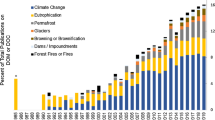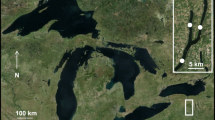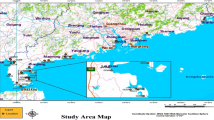Abstract
Methane (CH4) and carbon dioxide emissions from lakes are relevant for assessing the greenhouse gas output of wetlands. However, only few standardized datasets describe concentrations of these gases in lakes across different geographical regions. We studied concentrations and stable carbon isotopic composition (δ13C) of CH4 and dissolved inorganic carbon (DIC) in 32 small lakes from Finland, Sweden, Germany, the Netherlands, and Switzerland in late summer. Higher concentrations and δ13C values of DIC were observed in calcareous lakes than in lakes on non-calcareous areas. In stratified lakes, δ13C values of DIC were generally lower in the hypolimnion due to the degradation of organic matter (OM). Unexpectedly, increased δ13C values of DIC were registered above the sediment in several lakes. This may reflect carbonate dissolution in calcareous lakes or methanogenesis in deepwater layers or in the sediments. Surface water CH4 concentrations were generally higher in western and central European lakes than in Fennoscandian lakes, possibly due to higher CH4 production in the littoral sediments and lateral transport, whereas CH4 concentrations in the hypolimnion did not differ significantly between the regions. The δ13C values of CH4 in the sediment suggest that δ13C values of biogenic CH4 are not necessarily linked to δ13C values of sedimentary OM but may be strongly influenced by OM quality and methanogenic pathway. Our study suggests that CH4 and DIC cycling in small lakes differ between geographical regions and that this should be taken into account when regional studies on greenhouse gas emissions are upscaled to inter-regional scales.







Similar content being viewed by others
References
Assayag N, Rivé K, Ader M et al (2006) Improved method for isotopic and quantitative analysis of dissolved inorganic carbon in natural water samples. Rapid Commun Mass Spectrom 20:2243–2251. doi:10.1002/rcm.2585
Aucour A-M, Sheppard SMF, Guyomar O, Wattelet J (1999) Use of 13C to trace origin and cycling of inorganic carbon in the Rhône river system. Chem Geol 159:87–105. doi:10.1016/S0009-2541(99)00035-2
Bade DL, Pace ML, Cole JJ, Carpenter SR (2006) Can algal photosynthetic inorganic carbon isotope fractionation be predicted in lakes using existing models? Aquat Sci 68:142–153. doi:10.1007/s00027-006-0818-5
Barker JF, Fritz P (1981) Carbon isotope fractionation during microbial methane oxidation. Nature 293:289–291. doi:10.1038/293289a0
Bastviken D, Ejlertsson J, Tranvik LJ (2002) Measurement of methane oxidation in lakes: a comparison of methods. Environ Sci Technol 36:3354–3361. doi:10.1021/es010311p
Bastviken D, Cole JJ, Pace ML, Tranvik LJ (2004) Methane emissions from lakes: dependence of lake characteristics, two regional assessments, and a global estimate. Glob Biogeochem Cycles 18:1–12. doi:10.1029/2004GB002238
Bastviken D, Cole JJ, Pace ML, Van de Bogert MC (2008) Fates of methane from different lake habitats: connecting whole-lake budgets and CH4 emissions. J Geophys Res 113:1–13. doi:10.1029/2007JG000608
Bastviken D, Santoro AL, Marotta H et al (2010) Methane emissions from Pantanal, South America, during the low water season: toward more comprehensive sampling. Environ Sci Technol 44:5450–5455. doi:10.1021/es1005048
Bastviken D, Tranvik LJ, Downing JA et al (2011) Freshwater methane emissions offset the continental carbon sink. Science 331:50. doi:10.1126/science.1196808
Bogard MJ, Del Giorgio PA, Boutet L et al (2014) Oxic water column methanogenesis as a major component of aquatic CH4 fluxes. Nat Commun 5:5350. doi:10.1038/ncomms6350
Conrad R (2005) Quantification of methanogenic pathways using stable carbon isotopic signatures: a review and a proposal. Org Geochem 36:739–752. doi:10.1016/j.orggeochem.2004.09.006
Conrad R, Chan O-C, Claus P, Casper P (2007) Characterization of methanogenic Archaea and stable isotope fractionation during methane production in the profundal sediment of an oligotrophic lake (Lake Stechlin, Germany). Limnol Oceanogr 52:1393–1406. doi:10.4319/lo.2007.52.4.1393
Duc NT, Crill PM, Bastviken D (2010) Implications of temperature and sediment characteristics on methane formation and oxidation in lake sediments. Biogeochemistry 100:185–196. doi:10.1007/s10533-010-9415-8
Encinas Fernández J, Peeters F, Hofmann H (2014) Importance of the autumn overturn and anoxic conditions in the hypolimnion for the annual methane emissions from a temperate lake. Environ Sci Technol 48:7297–7304. doi:10.1021/es4056164
Enrich-Prast A, Bastviken D, Crill PM (2009) Chemosynthesis. In: Likens GE (ed) Encycl. inl. waters. Elsevier, Amsterdam, pp 211–225
Fry B (2006) Stable isotope ecology. Springer, New York
Grossart H-P, Frindte K, Dziallas C et al (2011) Microbial methane production in oxygenated water column of an oligotrophic lake. Proc Natl Acad Sci USA 108:19657–19661. doi:10.1073/pnas.1110716108
Guillemette F, McCallister SL, del Giorgio PA (2013) Differentiating the degradation dynamics of algal and terrestrial carbon within complex natural dissolved organic carbon in temperate lakes. J Geophys Res Biogeosci 118:963–973. doi:10.1002/jgrg.20077
Herczeg AL (1987) A stable carbon isotope study of dissolved inorganic carbon cycling in a softwater lake. Biogeochemistry 4:231–263
Hornibrook ERC, Longstaffe FJ, Fyfe WS (1997) Spatial distribution of microbial methane production pathways in temperate zone wetland soils: stable carbon and hydrogen isotope evidence. Geochim Cosmochim Acta 61:745–753. doi:10.1016/S0016-7037(96)00368-7
Hornibrook ERC, Longstaffe FJ, Fyfe WS (2000) Evolution of stable carbon isotope compositions for methane and carbon dioxide in freshwater wetlands and other anaerobic environments. Geochim Cosmochim Acta 64:1013–1027. doi:10.1016/S0016-7037(99)00321-X
Huotari J, Ojala A, Peltomaa E et al (2009) Temporal variations in surface water CO2 concentration in a boreal humic lake based on high-frequency measurements. Boreal Envriron Res 14:48–60
Huotari J, Nykänen H, Forsius M, Arvola L (2013) Effect of catchment characteristics on aquatic carbon export from a boreal catchment and its importance in regional carbon cycling. Glob Chang Biol 19:3607–3620. doi:10.1111/gcb.12333
ISO (1994) Swedish standard, water quality—examination and determination of colour. SS-EN ISO 7887:2011 (modified)
Juutinen S, Rantakari M, Kortelainen P et al (2009) Methane dynamics in different boreal lake types. Biogeosciences 6:209–223. doi:10.5194/bg-6-209-2009
Kankaala P, Taipale SJ, Nykänen H, Jones RI (2007) Oxidation, efflux, and isotopic fractionation of methane during autumnal turnover in a polyhumic, boreal lake. J Geophys Res 112:1–7. doi:10.1029/2006JG000336
Kankaala P, Huotari J, Tulonen T, Ojala A (2013) Lake-size dependent physical forcing drives carbon dioxide and methane effluxes from lakes in a boreal landscape. Limnol Oceanogr 58:1915–1930. doi:10.4319/lo.2013.58.6.1915
Kindler R, Siemens J, Kaiser K et al (2011) Dissolved carbon leaching from soil is a crucial component of the net ecosystem carbon balance. Glob Chang Biol 17:1167–1185. doi:10.1111/j.1365-2486.2010.02282.x
Kortelainen P, Rantakari M, Huttunen JT et al (2006) Sediment respiration and lake trophic state are important predictors of large CO2 evasion from small boreal lakes. Glob Chang Biol 12:1554–1567. doi:10.1111/j.1365-2486.2006.01167.x
Lennon JT, Faiia AM, Feng X, Cottingham KL (2006) Relative importance of CO2 recycling and CH4 pathways in lake food webs along a dissolved organic carbon gradient. Limnol Oceanogr 51:1602–1613. doi:10.4319/lo.2006.51.4.1602
Leuenberger MC, Nyfeler P, Moret HP et al (2000a) A new gas inlet system for an isotope ratio mass spectrometer improves reproducibility. Rapid Commun Mass Spectrom 14:1543–1551. doi:10.1002/1097-0231(20000830)14:16<1543:AID-RCM62>3.0.CO;2-H
Leuenberger MC, Nyfeler P, Moret HP et al (2000b) CO2 concentration measurements on air samples by mass spectrometry. Rapid Commun Mass Spectrom 14:1552–1557. doi:10.1002/1097-0231(20000830)14:16<1552:AID-RCM63>3.0.CO;2-C
Liikanen A, Murtoniemi T, Tanskanen H et al (2002) Effects of temperature and oxygen availability on greenhouse gas and nutrient dynamics in sediment of a eutrophic mid-boreal lake. Biogeochemistry 59:269–286. doi:10.1023/A:1016015526712
Lojen S, Ogrinc N, Dolenec T (1999) Decomposition of sedimentary organic matter and methane formation in the recent sediment of Lake Bled (Slovenia). Chem Geol 159:223–240. doi:10.1016/S0009-2541(99)00032-7
López Bellido J, Tulonen T, Kankaala P, Ojala A (2009) CO2 and CH4 fluxes during spring and autumn mixing periods in a boreal lake (Pääjärvi, southern Finland). J Geophys Res 114:1–12. doi:10.1029/2009JG000923
López Bellido J, Tulonen T, Kankaala P, Ojala A (2012) Concentrations of CO2 and CH4 in water columns of two stratified boreal lakes during a year of atypical summer precipitation. Biogeochemistry 113:613–627. doi:10.1007/s10533-012-9792-2
Mandic-Mulec I, Gorenc K, Petrišič MG et al (2012) Methanogenesis pathways in a stratified eutrophic alpine lake (Lake Bled, Slovenia). Limnol Oceanogr 57:868–880. doi:10.4319/lo.2012.57.3.0868
Marotta H, Pinho L, Gudasz C et al (2014) Greenhouse gas production in low-latitude lake sediments responds strongly to warming. Nat Clim Chang 4:467–470. doi:10.1038/NCLIMATE2222
McAuliffe CD (1971) GC determination of solutes by multiple phase equilibration. Chem Technol 1:46–51
McKenzie J (1982) Carbon-13 cycle in Lake Greifen: a model for restricted ocean basins. In: Schlanger S, Cita M (eds) Nature and origin of cretaceous carbon-rich facies. Academic Press, London, pp 197–208
Meyers PA, Teranes JL (2001) Sediment organic matter. In: Last WM, Smol JP (eds) Track enviromental change using lake sediments. Phys geochemical methods, vol 2. Kluwer Academic Publishers, Dordrecht, pp 239–269
Murase J, Sugimoto A (2001) Spatial distribution of methane in the Lake Biwa sediments and its carbon isotopic compositions. Geochem J 35:257–263. doi:10.2343/geochemj.35.257
Murase J, Sakai Y, Sugimoto A et al (2003) Sources of dissolved methane in Lake Biwa. Limnology 4:91–99. doi:10.1007/s10201-003-0095-0
Myrbo A, Shapley MD (2006) Seasonal water-column dynamics of dissolved inorganic carbon stable isotopic compositions (δ13CDIC) in small hardwater lakes in Minnesota and Montana. Geochim Cosmochim Acta 70:2699–2714. doi:10.1016/j.gca.2006.02.010
Oana S, Deevey ES (1960) Carbon 13 in lake waters, and its possible bearing on paleolimnology. Am J Sci 258:253–272
Ormerod JG (1983) Studies in microbiology. Anaerobic life in the light. The phototrophic bacteria, vol 4. Blackwell Scientific Publications, Oxford
R Core Team (2013) R: a language and environment for statistical computing. R Foundation for Statistical Computing, Vienna, Austria. ISBN 3-900051-07-0. http://www.R-project.org/
Rantakari M, Kortelainen P (2008) Controls of organic and inorganic carbon in randomly selected Boreal lakes in varied catchments. Biogeochemistry 91:151–162. doi:10.1007/s10533-008-9266-8
Raymond PA, Hartmann J, Lauerwald R et al (2013) Global carbon dioxide emissions from inland waters. Nature 503:355–359. doi:10.1038/nature12760
Romanek CS, Grossman EL, Morse JW (1992) Carbon isotopic fractionation in synthetic aragonite and calcite: effects of temperature and precipitation rate. Geochim Cosmochim Acta 56:419–430. doi:10.1016/0016-7037(92)90142-6
Rosenfeld WD, Silverman SR (1959) Carbon isotope fractionation in bacterial production of methane. Science 130:1658–1659. doi:10.1126/science.130.3389.1658-a
Rudd JWM, Hamilton RD (1978) Methane cycling in a eutrophic shield lake and its effects on whole lake metabolism. Limnol Oceanogr 23:337–348. doi:10.4319/lo.1978.23.2.0337
Rudd JWM, Furutani A, Flett RJ, Hamilton RD (1976) Factors controlling methane oxidation in shield lakes: the role of nitrogen fixation and oxygen concentration. Limnol Oceanogr 21:357–364
Schilder J, Bastviken D, van Hardenbroek M et al (2013) Spatial heterogeneity and lake morphology affect diffusive greenhouse gas emission estimates of lakes. Geophys Res Lett 40:5752–5756. doi:10.1002/2013GL057669
Schubert CJ, Diem T, Eugster W (2012) Methane emissions from a small wind shielded lake determined by eddy covariance, flux chambers, anchored funnels, and boundary model calculations: a comparison. Environ Sci Technol 46:4515–4522. doi:10.1021/es203465x
Sobek S, Algesten G, Bergström A-K et al (2003) The catchment and climate regulation of pCO2 in boreal lakes. Glob Chang Biol 9:630–641. doi:10.1046/j.1365-2486.2003.00619.x
Spigel RH, Imberger J (1987) Mixing processes relevant to phytoplankton dynamics in lakes. N Z J Mar Freshw Res 21:361–377. doi:10.1080/00288330.1987.9516233
Steinmann P, Eilrich B, Leuenberger MC, Burns SJ (2008) Stable carbon isotope composition and concentrations of CO2 and CH4 in the deep catotelm of a peat bog. Geochim Cosmochim Acta 72:6015–6026. doi:10.1016/j.gca.2008.09.024
Stets EG, Striegl RG, Aiken GR et al (2009) Hydrologic support of carbon dioxide flux revealed by whole-lake carbon budgets. J Geophys Res 114:G01008. doi:10.1029/2008JG000783
Stumm W, Morgan JJ (1996) Aquatic chemistry: chemical equilibria and rates in natural waters, 3rd edn. Wiley, New York
Tang KW, McGinnis DG, Frindte K et al (2014) Paradox reconsidered: methane oversaturation in well-oxygenated lake waters. Limnol Oceanogr 59:275–284. doi:10.4319/lo.2014.59.1.0275
Troen I, Petersen EL (1989) European wind atlas. Risoe National Laboratory, Roskilde
Valentino FL, Leuenberger M, Uglietti C, Sturm P (2008) Measurements and trend analysis of O2, CO2 and δ13C of CO2 from the high altitude research station Junfgraujoch, Switzerland—a comparison with the observations from the remote site Puy de Dôme, France. Sci Total Environ 391:203–210. doi:10.1016/j.scitotenv.2007.10.009
Verpoorter C, Kutser T, Seekell DA, Tranvik LJ (2014) A global inventory of lakes based on high-resolution satellite imagery. Geophys Res Lett 41:6396–6402. doi:10.1002/2014GL060641
Wachniew P, Różański K (1997) Carbon budget of a mid-latitude, groundwater-controlled lake: isotopic evidence for the importance of dissolved inorganic carbon recycling. Geochim Cosmochim Acta 61:2453–2465. doi:10.1016/S0016-7037(97)00089-6
West WE, Coloso JJ, Jones SE (2012) Effects of algal and terrestrial carbon on methane production rates and methanogen community structure in a temperate lake sediment. Freshw Biol 57:949–955. doi:10.1111/j.1365-2427.2012.02755.x
Whitfield CJ, Aherne J, Baulch HM (2011) Controls on greenhouse gas concentrations in polymictic headwater lakes in Ireland. Sci Total Environ 410–411:217–225. doi:10.1016/j.scitotenv.2011.09.045
Whiticar MJ (1999) Carbon and hydrogen isotope systematics of bacterial formation and oxidation of methane. Chem Geol 161:291–314. doi:10.1016/S0009-2541(99)00092-3
Whiticar MJ, Faber E, Schoell M (1986) Biogenic methane formation in marine and freshwater environments: CO2 reduction vs. acetate fermentation—isotope evidence. Geochim Cosmochim Acta 50:693–709. doi:10.1016/0016-7037(86)90346-7
Yvon-Durocher G, Allen AP, Bastviken D et al (2014) Methane fluxes show consistent temperature dependence across microbial to ecosystem scales. Nature 507:488–491. doi:10.1038/nature13164
Zyakun AM, Lunina ON, Prusakova TS et al (2009) Fractionation of stable carbon isotopes by photoautotrophically growing anoxygenic purple and green sulfur bacteria. Microbiology 78:757–768. doi:10.1134/S0026261709060137
Acknowledgments
We thank Willi Tanner, Jussi Jyväsjärvi, and Olli Nousiainen for assistance in the field, Henrik Reyer, Jaakko Vainionpää, and Peter Nyfeler for assistance in the laboratory, Roger Jones and Lammi Biological Station for facilitating the field work in Finland, and Winfried Lampert and Jonathan Grey for facilitating the field work in Germany. We also thank two anonymous referees for comments, which helped us to improve the manuscript. The research leading to these results has received funding from the European Research Council under the European Union’s Seventh Framework Programme (FP/2007-2013)/ERC Grant Agreement no. 239858 (RECONMET).
Author information
Authors and Affiliations
Corresponding author
Electronic supplementary material
Below is the link to the electronic supplementary material.
Rights and permissions
About this article
Cite this article
Rinta, P., Bastviken, D., van Hardenbroek, M. et al. An inter-regional assessment of concentrations and δ13C values of methane and dissolved inorganic carbon in small European lakes. Aquat Sci 77, 667–680 (2015). https://doi.org/10.1007/s00027-015-0410-y
Received:
Accepted:
Published:
Issue Date:
DOI: https://doi.org/10.1007/s00027-015-0410-y




